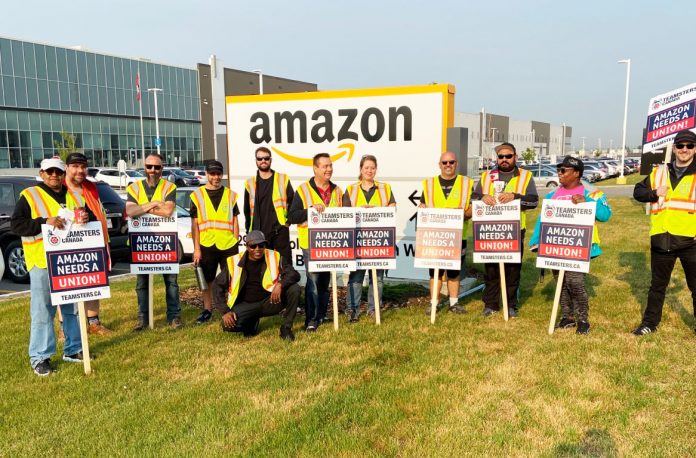
The recent unionization drive in Amazon warehouses in the United States is now reverberating in Canada. In Quebec, the CSN began a unionization drive at the Lachine distribution center. In Ontario, Teamsters’ union representatives could be seen handing out pamphlets at the entrances to facilities in Cambridge, London, Milton, and Kitchener. In Alberta, Teamsters Local 362 is attempting, for the second time, to unionize the Nisku warehouse near Edmonton. These efforts are a reminder of the urgent need to unionize the non-unionized.
Amazon has earned a reputation for making employees work at a frantic pace, even threatening to fire them if they fall behind. Workers have repeatedly complained that working at this extreme pace compromises their safety, especially during the pandemic.
The Nisku warehouse was a hotbed of COVID-19 infections. Despite this, Alberta’s conservative government kept the warehouse open, declaring it “essential”. Amazon has gambled with workers’ health for the sake of profits. These workers have every reason to unionize.
Obviously, the suits at Amazon are extremely unhappy about these unionization efforts. The company has resorted to several anti-union tactics, including holding one-on-one meetings with workers to discourage them from unionizing. They also sent out text messages to all employees stating that the union would take away their benefits plan. At the Lachine warehouse, the company dedicated its May edition of the employee “newsletter” to addressing the unionization efforts—a practice the CSN says is illegal.
On top of this, during the initial Nisku union drive last year, Amazon artificially inflated the list of employees by signing up workers who had left their jobs months earlier. This prevented the union from reaching the threshold of 40 per cent in favour, causing the unionization vote to fail.
To discourage workers in Canada from unionizing, Amazon recently increased starting wages from $16 to $17 an hour. Even so, Amazon workers’ wages, which range from $17 to $19 an hour, remain well below the $25 to $30 average that unionized warehouse workers receive. This gap is all the more outrageous considering that the company raked in record profits of $89 billion (USD) during the pandemic, a 40 per cent increase in revenue.
Unionizing the non-unionized
The inspiring victory won by the independent Amazon Labor Union (ALU), at the Staten Island Amazon warehouse, has spurred these efforts in Canada. This David-and-Goliath victory has sparked a wave of inspiration around the world and shown millions of workers it is possible to stand up to the bosses.
The unionization of Amazon’s warehouses, far from being an isolated incident, is part of a general working-class awakening in the United States. Under the pressure of rising inflation, American workers are beginning to organize collectively to defend their standard of living. The growing number of Starbucks shops joining the SBWorkersUnited union shows this. Workers at other large companies, like Apple, Target, and Trader Joe’s, are also leading unionization efforts. In October 2021, more than 100,000 workers across the United States voted to strike under the slogan #striketober.
In Canada, the labour movement has been slower to take action. These Amazon warehouse unionization efforts are a good start, but they are the exception rather than the rule. The big unions have long minimized their efforts to organize the non-unionized, particularly in the service sector. They claim this is too difficult because of the high turnover, young age of the workers, and anti-union manoeuvring by the bosses.
As a result, unionization rates have been declining for decades. While the situation is not as bad as in the United States, where only 10.3 per cent of workers are unionized, the unionization rate in Canada has dropped from 37.6 per cent in 1981 to 30.9 per cent in 2021.
It is absolutely crucial to organize workers. As Marx said, without organization, workers are just raw material for exploitation. A unionized working class is stronger and better able to resist the bosses’ attacks on their standards of living. Workers becoming conscious of their common interests, how these are opposed to those of the bosses, and the need to unite to defend these interests are the first steps in developing a revolutionary consciousness. The big unions have immense resources that should be devoted to organizing the broad layers of unorganized workers.
Fighting to win
To achieve this, the major trade unions in Canada should follow the inspiring example of the ALU. Their victory did not come out of nowhere. The Staten Island campaign succeeded because it inspired workers and convinced them to mobilize. The ALU tied its campaign to concrete demands that could actually improve the lives of workers: a $30-per-hour wage, two paid 30-minute breaks, and a paid lunch hour. This is an important lesson for the CSN and Teamster campaigns here in Canada. Workers will only join a union with the perspective of winning real improvements.
The example of young unions like the ALU is inspiring, but it is the big unions that have the resources and the numbers to defend workers against the attacks of management. To mobilize the immense potential of the working class, the big unions must take this example to heart.
VICTORY TO THE AMAZON WORKERS!
FOR MILITANT TRADE UNIONISM!

